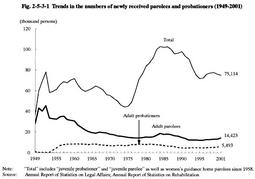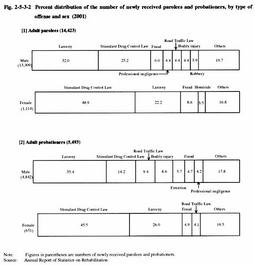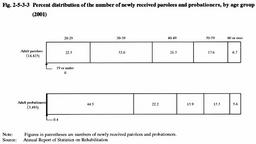| Previous Next Index Image Index Year Selection | |
|
|
2 State of probationary supervision (1) Trends in probation cases In this subsection, we will give an overview of the trends in probation cases, focusing on adult parolees and adult probationers (for juvenile probationers and juvenile parolees, see Part 4, Chapter 2, Section 6-2 .)
Fig. 2-5-3-1 shows the trends in the numbers of parolees and probationers newly received by probation offices since 1949 as well as the total number of parolees and probationers (see Appendix 2-13 ). Fig. 2-5-3-1 Trends in the numbers of newly received parolees and probationers (1949-2001) The number of adult parolees had been within the range of 12,000 or over but below 13,000 since 1992, but gradually increased since 1996 and reached 13,256 in 1999. In 2001, the number increased by 1,169 from the previous year to 14,423.The number of adult probationers had been within the range of 5,000 or over but below 6,000 since 1997, but decreased by 190 from the previous year to 5,493 in 2001. In recent years, probation offices have received no parolees from women's guidance homes. Fig. 2-5-3-2 shows the percent distribution of the number of parolees and probationers newly received in 2001, by type of offense. The percentages of adult parolees and adult probationers who committed larceny and Stimulant Drug Control Law violations were high. In particular, the percentage of Stimulant Drug Control Law violations was extremely high for female parolees and probationers. Fig. 2-5-3-3 shows the percent distribution of the number of parolees and probationers newly received in 2001, by age group. Viewing parolees newly received in 2001 by period of probationary supervision, 39.6% of them were placed on probationary supervision for 3 months or less, 32.6% for 6 months or less, 22.6% for 1 year or less, and 5.2% for over 1 year (Source: Annual Report of Statistics on Rehabilitation). Fig. 2-5-3-2 Percent distribution of the number of newly received parolees and probationers, by type of offense and sex (2001) Fig. 2-5-3-3 Percent distribution of the number of newly received parolees and probationers, by age group (2001) (2) Treatment during probationary supervision a. Measures for probationers and parolees with good records
For probationers and parolees whose behavior has become stable and who are considered unlikely to commit repeat offenses during the period of probationary supervision, the following good-conduct measures shall be implemented: indeterminate sentence parolees who have served their minimum term shall be granted termination of indeterminate sentence, as if they have completed their sentences; adult probationers shall be granted provisional discharge from probationary supervision. In 2001, as good-conduct measures, 1 parolee (1 in 2000) was granted termination of indeterminate sentence and 591 probationers (546 in 2000) were granted provisional discharge from probationary supervision (Source: Annual Report of Statistics on Rehabilitation). b. Measures for parolees and probationers with bad records For parolees and probationers who have violated the conditions of probationary supervision or committed repeat offenses, the following bad-conduct measures shall be taken: adult parolees shall be subject to revocation of parole and they shall be imprisoned in penal institutions; adult parolees whose whereabouts is unknown shall be subject to suspension of probation and the progress of their sentences shall be interrupted; adult probationers shall be subject to revocation of suspended sentence and they shall be imprisoned in penal institutions; and women's guidance home parolees shall be subject to revocation of provisional discharge and they shall be detained in women's guidance homes again. In 2001, as bad-conduct measures, 594 adult parolees (601 in 2000) were subject to suspension of probation, 991 (1,016 in 2000) to revocation of parole, and 1,739 (1,777 in 2000) adult probationers were subject to revocation of suspended sentence (Source: Annual Report of Statistics on Rehabilitation). Where parolees and probationers fail to reside in a fixed abode or there are sufficient reasons to suspect that they have violated the conditions of probationary supervision, and they fail or would fail to respond when summoned by a probation office director, they shall be apprehended under an arrest warrant issued by a judge. Following a decision to commence examination for bad-conduct measures, they shall be detained in the appropriate institution for a fixed term In 2001, including juvenile probationers and juvenile parolees, 215 probationers and parolees (195 in 2000) were apprehended and 164 (159 in 2000) were detained in this manner (Source: Annual Report of Statistics on Rehabilitation). |


